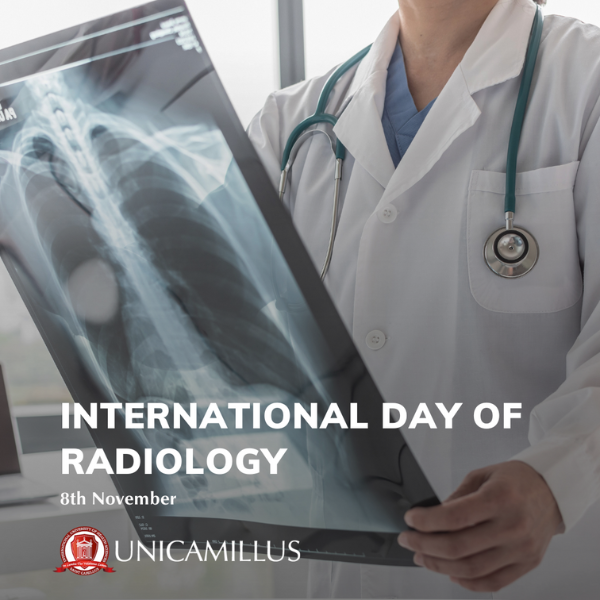Radiology, innovation that bridges the past and the future,
for ever more precise and less invasive diagnoses: an interview with Professor Argirò.
Today, 8 November, we celebrate International Day of Radiology (IDoR) 2023. The date chosen coincides with the anniversary of the discovery of X-rays: it was 8 November 1895, and its father was the German physicist Wilhelm Conrad Roentgen.
IDoR was founded in 2012 as a joint initiative of the RSNA ‒ Radiological Society of North America, the ACR ‒ American College of Radiology, and the ESR ‒ European Society of Radiology, with the participation of the SIRM ‒ Società Italiana di Radiologia Medica ed Interventistica.
The advent of Radiology has had a significant impact on medical practice, leading to several changes in healthcare.
First and foremost, it has made diagnoses more precise, thanks to the ability to explore the inside of the human body in a way that was not possible before. This has allowed doctors to diagnose lesions, tumours, inflammation, bone degeneration or fractures more accurately, thus enabling early detection.
Radiology has also made it possible to monitor the progression of certain pathological conditions, allowing precise follow-up and evaluation of the effectiveness of treatments.
And let us not forget the role of interventional radiology, such as vascular radiology, which has made it possible to make diagnoses inside the human body with minimal incisions and non-invasive surgical procedures, leading to safer procedures and shorter recovery time for patients.
So, what is the future of radiology? We discussed this with Professor Renato Argirò, Professor of Diagnostic Imaging and Radiotherapy on the MSc Medicine and Surgery and the BSc Radiology, Diagnostic Imaging and Radiotherapy Techniques at UniCamillus University, Rome.
What are the current challenges in Radiology?
The current challenges in medical imaging are aimed at improving the ability to make increasingly early and accurate diagnoses of any type of pathology, whether they be benign or in the field of oncology. Radiology has always been closely linked to technological development, and the introduction of new technologies, machines and new applications will enable us to obtain more detailed images with reduced acquisition times. The field of radiology is also complemented by interventional radiology, a rapidly developing discipline that allows diagnostic and therapeutic procedures to be carried out using minimally invasive techniques, resulting in lower complication rates and shorter hospital stays. The use of these procedures is developing rapidly, with a steady increase in the number of patients undergoing this type of intervention.
Radiology and Artificial Intelligence: Where are we?
Artificial intelligence, in a discipline historically linked to technological development such as radiology, may lead to another technological “revolution” with improved diagnostic capabilities and diagnostic precision. Moreover, the possibility of being assisted by this ‘new technology’ facilitates the move towards automation, making it easier to read and interpret images. With deep learning, AI algorithms can be trained to detect abnormalities in images and flag these findings for the radiologist, who will remain central to their interpretation.
We are getting closer every day to the clinical use of AI: many algorithms have already been developed and are showing promising results, for example in the early diagnosis of lung cancer. However, we have not yet reached the point where it can be used on a daily basis, but we expect promising developments in the coming years, especially in the field of oncology.
Imaging and patient safety: are the risks associated with radiation lower than in the past?
It is clear that some radiological techniques, in particular CT scans, involve the use of ionising radiation. These techniques are currently irreplaceable, especially in emergency situations where early diagnosis is crucial for prompt patient treatment.
Technological advances, with the development of new image acquisition and reconstruction algorithms, have undoubtedly led to a significant reduction in the amount of ionising radiation administered to the patient, making radiological examinations safer from a dosimetric point of view.
How is the training of new radiologists at UniCamillus evolving to prepare professionals for the world of work in this medical field? It is a continuous evolutionary process. The foundations of the discipline are solid, and its principles are internationally recognised. The role of the radiologist is, and will continue to be, increasingly important in clinical practice as imaging becomes more indispensable. Indeed, the use of diagnostic imaging in current practice allows the interpretation and correlation of clinical information, laboratory findings and patient symptoms with imaging results. It is therefore becoming increasingly important for a radiologist not only to acquire and interpret images, but also to have a comprehensive understanding of different pathologies in order to assist and guide colleagues towards the most appropriate treatment pathways.

